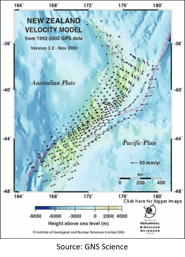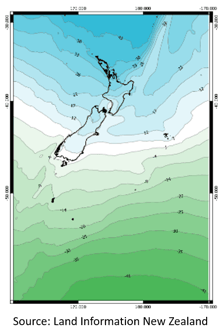Positioning geospatial data for the 21st Century - it’s time to switch to modern datums
by Andrew Clouston, Senior Consultant, on 08-Oct-2019 12:53:55

The business case is clear for migrating from NZGD1949 to NZGD2000 and to use NZVD2016
Twenty years ago, Land Information New Zealand recognised that New Zealand needed to ensure that its positioning infrastructure was in line with global systems, such as GPS. The first step was a new geodetic datum and associated projections; the second step was to improve how heights are defined with a new vertical datum.
Relying on deprecated systems not only means that the advantages of the new methods are not realised; it also means that an informal hybrid system may operate where new data is continually changed to match old data. This continual overhead cost may not be obvious to managers and it may also be introducing error and other risks.
In this blog, we will reflect on three key considerations to ensure that your spatial data remains fit for purpose:
- Datum/projection selection
- Tectonic movement and the risk of positional inaccuracy
- The accuracy of height data
Datum/Projection Selection
A datum is a reference surface which is used to describe the size and shape of the earth.
New Zealand’s original datum, NZGD1949 (New Zealand Geodetic Datum 1949) was a custom definition that was only suitable for New Zealand and is now considered to be “incompatible with global geodetic reference systems (e.g. GPS)” (Source: LINZ).
A new datum was needed, as were new official projections which convert the round shape of the earth to a flat surface (like a paper map or computer monitor). Accordingly, the New Zealand government moved from the national datum/projection combination of NZGD1949/NZMG (NZ Geodetic Datum/NZ Map Grid) to NZGD2000/NZTM (NZ Geodetic Datum/NZ Transverse Mercator), which is now the default system in New Zealand and is in step with the rest of the world.
Not migrating from a NZGD1949 base to a NZGD2000 base 20 years ago carried little risk, since conversion between these two systems is possible, albeit with varying degrees of accuracy. But as the new datum/projection combinations have become the predominant definition for New Zealand spatial data, organisations still using the old datum/projections are increasingly out-of-step and gradually exposing themselves to greater risk through unnecessary data conversion, and challenges with keeping aligned to New Zealand’s ever-changing landscape as a result of tectonic movement.
Tectonic movement and the risk of positional inaccuracy
 The warping or deformation effects of tectonic movement across New Zealand are quite significant over time and should be considered when converting or merging data from one datum to another.
The warping or deformation effects of tectonic movement across New Zealand are quite significant over time and should be considered when converting or merging data from one datum to another.
Tectonic movement varies across New Zealand. As you can see in the image on the left, Auckland is virtually stationary whilst Christchurch moves at a rate of about 40 mm per year to the southwest.
How this cumulative effect manifests itself in your data depends on the quality and accuracy of the original data and how you manage the transformation. Poor transformations would assume a “static earth” and potentially introduce a positional discrepancy.
The accuracy of elevations
If you obtain elevations or heights direct from satellite systems, then all the more reason to consider a change. Horizontal positioning datums use a reference ellipsoid, however, it does not perfectly match the reality of the earth’s centre of mass and gravity anomalies and variations. So, although ellipsoidal-based heights are locally consistent, they can easily end up being “offset” to systems that are based on or reflect gravity (such as sea level).
The figure on the right shows the differences between these two systems, in and around New Zealand - note the 40m difference in Northland (and imagine making key decisions regarding roading, rail or other infrastructure and not knowing if your elevations are based on different systems).
Implementing the New Zealand Vertical datum (NZVD2016) will ensure that you no longer have to use 13 separate, tide gauge-based vertical datums and manage the issues arising from “multiple official heights in areas of overlap”. It also means that “old elevations” can be easily converted and maintained in alignment to a modern gravity-based system, and that you can adopt and leverage the advantages and convenience of GPS-derived heights by applying a simple correction (which can be automated if you prefer).
Developing your business case for change
When your business is considering an upgrade to systems or data, then this would be the ideal time to migrate to Datum2000 and use NZVD2016.
Staying with the status quo is likely to increase the risk that your spatial data is not up to task and will increasingly make it harder to accurately “move in sync” with other geospatial data users across New Zealand and the world - unless you consistently keep accurate records on the exact time and methodology under which your spatial data was captured.
When you’re ready to make the business case for moving to NZGD2000 and/or NZVD2016, below are 6 compelling reasons to include in your brief:
- Reduce risk and improve efficiencies - moving to NZGD2000 for all your geospatial data and tools will reduce the time taken to re-project data between these different datums, and:
- It will reduce the risk that analysis will be unknowingly undertaken between datasets of different datums; and
- It avoids the risk of ad-hoc reprojections by people who may not have suitable technical knowledge or training.
- Improve accuracy - NZGD2000 supports modern survey techniques, remote sensing data collection, and related models and reference frames.
- Be compatible internationally - NZGD2000 is inherently more in step with the world than NZGD1949.
- Future proof your business - NZGD2000 is maintained to account for the deformational changes that have happened and will continue to happen throughout New Zealand due to earthquakes and plate movements.
- Continue to use ‘real world’ or orthometric heights and leverage the convenience of GPS data for height measurements.
- It's now the defacto system - if you’re using additional geospatial data from other organisations (such as aerial photography, LiDAR, clutter data, property boundaries, etc), it’s probably going to be the NZGD2000/NZTM combination, especially if it covers a large area or is part of a national dataset. Conversely, if others request your data, they will most likely want it in the NZGD2000/NZTM combination.
It’s always a good time to consider whether your spatial data is still meeting your business needs. Data conversion, including datum, elevations and projections, is largely a technical topic but some level of understanding of the impacts on your business is required, which is where Critchlow can help.
Our first step is to clearly understand how much of your data would need to be transformed, from which we can determine which methods are most appropriate, given variability in age and accuracy/precision of respective datasets. Contact us to discuss.
About the Author:
Andrew Clouston, BSurv, MGIS, RPSurv, GISP-AP is a Senior Consultant at Critchlow.




.png)